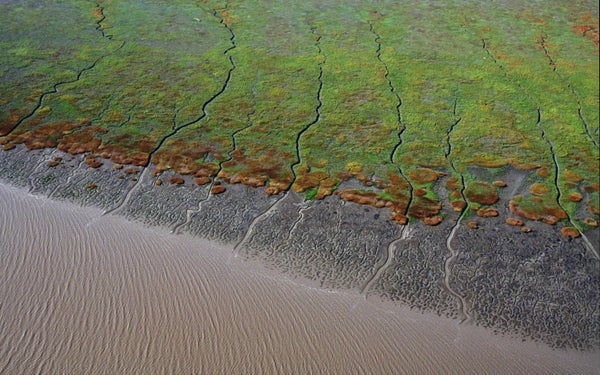February 1, 2024
2 min read
Wetlands with a small amount of salinity can produce more methane gas than those filled with freshwater or lots of seawater, new research suggests

Aerial view above tidal wetlands and mud flats South San Francisco Bay.
CLIMATEWIRE | Sea-level rise could cause some coastal wetlands to release huge quantities of methane gas, according to a new study that challenges how scientists view the relationship between salinity levels and climate-warming emissions.
Wetlands are diverse ecosystems that help protect nearby communities from floods and filter pollutants out of larger rivers and waterways. While they are also the largest natural source of methane emissions worldwide, how much of the gas is released depends on the wetland’s location and its characteristics — with some wetlands storing more greenhouse gases than they emit.
One important factor is saltiness. Scientists have theorized that wetlands with higher salinity levels — such as those along coastlines — emit less methane than freshwater wetlands. That’s because salty water is thought to be less hospitable to microorganisms that produce methane.
On supporting science journalism
If you’re enjoying this article, consider supporting our award-winning journalism by subscribing. By purchasing a subscription you are helping to ensure the future of impactful stories about the discoveries and ideas shaping our world today.
But researchers at Lawrence Berkeley National Laboratory found the opposite is sometimes true.
After studying 11 wetland zones in the San Francisco Bay Area, they found that one zone with a small amount of salt content emitted far more methane — up to 10 times as much — than other sites studied, including freshwater areas and those with high salinity.
The results of their research, published Monday in the journal mSystems, suggest that wetlands could start producing more greenhouse gases as climate change pushes more ocean water inland.
The research team collected sediment from wetlands in the Bay Area with a range of saltwater levels, from seawater to freshwater and everything in between, said Susannah Tringe, director of the environmental genomics and systems biology division at Berkeley Lab. The team then extracted the DNA of organisms found in the soil and sequenced it, looking for genes associated with methane production and methane consumption.
At the same time, the team measured methane and carbon dioxide levels in the soil cores themselves, said Tringe, senior author on the paper.
“The overall trend we saw was lower methane emissions in a high salinity environment and high methane emissions in the low salinity environment,” Tringe said. “But we were really surprised to see” that some of the “slightly saline environments had the very highest methane emissions that we saw across the whole gradient.”
Although more research is needed, the findings could help regulators better understand the methane and carbon footprints of different wetlands and make informed decisions about which ones should be restored or protected, she said.
The team’s results don’t dispute the idea that wetlands in very salty water emit less methane, likely because the saltwater affects organisms known as methanogens, which produce methane, Tringe said. Yet the results suggest that organisms that eat methane, known as methanotrophs, are affected in environments that are only slightly salty.
Another factor in the methane-producing, slightly salty wetlands could be plant decomposition, Tringe said. Dead plants are another source of methane, and it’s possible that they’re decomposing more rapidly in low saline zones.
Reprinted from E&E News with permission from POLITICO, LLC. Copyright 2023. E&E News provides essential news for energy and environment professionals.

